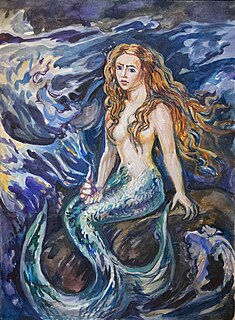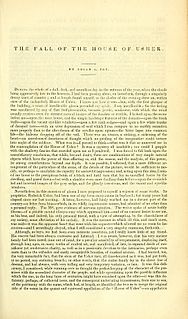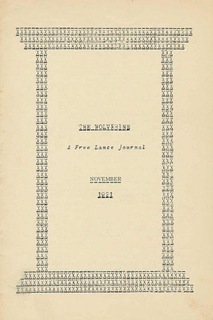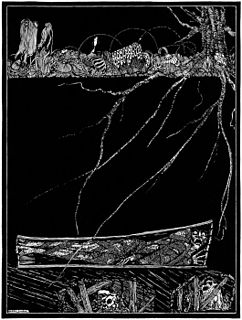Related Research Articles

Robert William Chambers was an American artist and fiction writer, best known for his book of short stories titled The King in Yellow, published in 1895.

"The Tell-Tale Heart" is a short story by American writer Edgar Allan Poe, first published in 1843. It is related by an unnamed narrator who endeavors to convince the reader of the narrator's sanity while simultaneously describing a murder the narrator committed. The victim was an old man with a filmy pale blue "vulture-eye", as the narrator calls it. The narrator emphasizes the careful calculation of the murder, attempting the perfect crime, complete with dismembering the body in the bathtub and hiding it under the floorboards. Ultimately, the narrator's actions result in hearing a thumping sound, which the narrator interprets as the dead man's beating heart.

"The Little Mermaid" is a Danish literary fairy tale written by the Danish author Hans Christian Andersen. The story follows the journey of a young mermaid who is willing to give up her life in the sea as a mermaid to gain a human soul. The tale was first published in 1837 as part of a collection of fairy tales for children. The original story has been a subject of multiple analyses by scholars such as Jacob Bøggild and Pernille Heegaard as well as the folklorist Maria Tatar. These analyses cover various aspects of the story from interpreting the themes to discussing why Andersen chose to write a tragic story with a happy ending. It has been adapted to various media, including musical theatre, anime, ballet, opera, and film. There is also a statue portraying the mermaid in Copenhagen, Denmark, where the story was written and first published.

"The Fall of the House of Usher" is a short story by American writer Edgar Allan Poe, first published in 1839 in Burton's Gentleman's Magazine, then included in the collection Tales of the Grotesque and Arabesque in 1840. The short story, a work of Gothic fiction, includes themes of madness, family, isolation, and metaphysical identities.

Oroonoko: or, the Royal Slave is a short work of prose fiction by Aphra Behn (1640–1689), published in 1688 by William Canning and reissued with two other fictions later that year. It was also adapted into a play. The eponymous hero is an African prince from Coramantien who is tricked into slavery and sold to European colonists in Surinam where he meets the narrator. Behn's text is a first-person account of Oroonoko's life, love, rebellion, and execution.

The Bloody Chamber is a collection of short fiction by English writer Angela Carter. It was first published in the United Kingdom in 1979 by Gollancz and won the Cheltenham Festival Literary Prize. The stories share a theme of being closely based upon fairytales or folk tales. However, Carter has stated:
My intention was not to do 'versions' or, as the American edition of the book said, horribly, 'adult' fairy tales, but to extract the latent content from the traditional stories.

I Sing the Body Electric! is a 1969 collection of short stories by Ray Bradbury. The book takes its name from an included short story of the same title, which in turn took the title from a poem by Walt Whitman published in his collection Leaves of Grass.

"The Nameless City" is a short horror story written by American writer H. P. Lovecraft in January 1921 and first published in the November 1921 issue of the amateur press journal The Wolverine. It is often considered the first story set in the Cthulhu Mythos world. In the story, the protagonist travels to the middle of the Arabian desert to explore an ancient underground city.

"Pickman's Model" is a short story by H. P. Lovecraft, written in September 1926 and first published in the October 1927 issue of Weird Tales. It was adapted for television in a 1971 episode of the Night Gallery anthology series, starring Bradford Dillman.

"The Premature Burial" is a horror short story by American writer Edgar Allan Poe, published in 1844 in The Philadelphia Dollar Newspaper. Its main character expresses concern about being buried alive. This fear was common in this period and Poe was taking advantage of the public interest. The story has been adapted to a film.
"The Red Room" is a short Gothic story written by H. G. Wells in 1894. It was first published in the March 1896 edition of The Idler magazine.
"The Hound" is a short story written by H. P. Lovecraft in September 1922 and published in the February 1924 issue of Weird Tales. It contains the first mention of Lovecraft's fictional text the Necronomicon.

"Cool Air" is a short story by the American horror fiction writer H. P. Lovecraft, written in March 1926 and published in the March 1928 issue of Tales of Magic and Mystery.
"Nyarlathotep" is a prose poem by H. P. Lovecraft. It was written in 1920 and first saw publication in that year's November issue of The United Amateur. The poem itself is a bleak view of human civilization in decline, and it explores the mixed sensations of desperation and defiance in a dying society.
"What the Moon Brings" is a prose poem by American horror fiction writer H. P. Lovecraft, written on June 5, 1922. This story was first published in the National Amateur in May 1923. It's shorter than most of Lovecraft's other short stories, and is essentially a fragment. The story is based on one of Lovecraft's dreams, a common technique.
"The Evil Clergyman" is an excerpt from a letter written by American horror fiction writer H. P. Lovecraft in 1933. After his death, it was published in the April 1939 issue of Weird Tales as a short story. The story was later adapted into the unreleased 1987 anthology film Pulse Pounders.
"The Dream of a Ridiculous Man" is a short story by Fyodor Dostoevsky. It chronicles the experiences of a man who decides that there is nothing of any value in the world. Slipping into nihilism with “terrible anguish”, he is determined to commit suicide. However, after a chance encounter with a young girl, he begins an inner journey that re-instills a love for his fellow man. The story first appeared in Dostoevsky's self-published monthly journal A Writer's Diary in 1877.
Hans Christian Andersen's The Little Mermaid is a Japanese anime film based on Hans Christian Andersen's 1837 eponymous fairy tale, released in 1975 by Toei Animation. Unlike the Disney adaptation released 14 years later, this film is closer to Andersen's story, notably in its preservation of the original and tragic ending. The two main protagonists are the youngest daughter of the royal family, Marina, and her best friend Fritz, an Atlantic dolphin calf. In Japan, this film was shown in the Toei Manga Matsuri in 1975. The film was later released in the United States, dubbed into English by G. G. Communications, Inc. and United Artists, Inc., on February 4, 1978.
Momal Rano or Mumal Rano is a romantic tale of Momal and Rano from the Sindhi folklore and Rajasthani folklore. It is a multifaceted story that entails adventure, magic, schemes, beauty, love, ordeals of separation and above all romantic tragedy.
"The Willows" is a novella by English author Algernon Blackwood, originally published as part of his 1907 collection The Listener and Other Stories. It is one of Blackwood's best known works and has been influential on a number of later writers. Horror author H.P. Lovecraft considered it to be the finest supernatural tale in English literature. "The Willows" is an example of early modern horror and is connected within the literary tradition of weird fiction.
References
- ↑ H.G. Wells, The Short Stories of H.G. Wells (London: Ernest Benn, 1927), p. 162.
- ↑ Wells, The Soul of a Bishop and Three Short Stories (London, 1933), p. 233.
- ↑ Wells, The Soul of a Bishop and Three Short Stories, p. 236.
- ↑ David C. Smith, H.G. Wells: Desperately Mortal: A Biography (Yale University Press, 1986), p. 416.